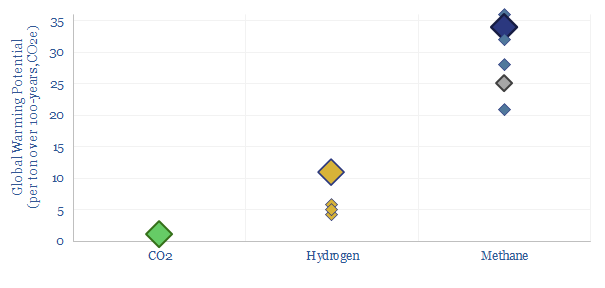This data-file aggregates technical data into the Global Warming Potential (GWP) of hydrogen, in order to draw conclusions for decision-makers in the energy transition. So what is hydrogen GWP versus methane?
(1) Hydrogen is not a direct GWP, as H-H bonds in the hydrogen molecule do not directly absorb infrared radiation, indeed nor do other symmetrical diatomic molecules like N2 or O2 (no permanent dipole moments).
(2) But hydrogen is an indirect GWP, as it breaks down in the atmosphere over 1-2 years, and its reaction products increase the GWP impacts of other GHGs, such as methane, tropospheric ozone and stratospheric water vapor.
(3) The best estimates we have tabulated in our data-file give a 100-year GWP for hydrogen that is 11x stronger than CO2 and for methane that is 34x stronger than CO2 (please download the data-file for the details).
(4) Concerns? In other words, if you are worried about the climate impacts of leaking 0.6 – 3.5% methane across global gas value chains, the climate impacts are effectively the same for leaking 2 – 10% hydrogen across a hydrogen value chain.
(5) 3x higher hydrogen leakage rates are not an unjustified concern, because the radius of an H2 molecule is about 3x smaller than the radius of a CH4 molecule, and the boiling point is -253C (versus -162C for methane) resulting in more boil-off, and thus upper estimates for H2 leakage rates as high as 20% have crossed our screen.
(6) The hydrogen industry might adapt: by monitoring and mitigating its leakage rates, much like the gas industry needs to do; and by preferring shorter and simpler value chains, direct substitution for pre-existing hydrogen in industry; or transporting hydrogen in carrier molecules (toluene, ammonia, electrofuels are less likely to result in hydrogen emissions, even if they are more expensive).
(7) CH4 Condemnation? Over 50% of the GWP impacts of hydrogen arise because hydrogen mops up hydroxyl radicals, which in turn, prevents these hydroxyl radicals from breaking down methane molecules. Thus the 100-year warming impacts of methane are exacerbated. In other words, the climate impacts of atmospheric hydrogen directly link to the atmospheric impacts of methane. The more worried you are about one, then logically, the more worried you should be about the other. Hydrogen and methane are “in it together” when it comes to GWP.
(8) CH4 Collaboration. Atmospheric methane is around 1,900 ppb, 160% above pre-industrial levels. Every year, about 40% of the world’s methane emissions comes from natural sources like wetlands, 25% from agriculture, cow burps and rice, 25% from coal, oil and gas and c10% from waste landfills. H2’s GWP can be improved by encouraging better methane management in all of these other categories.
Recent Commentary: please see our article here.
